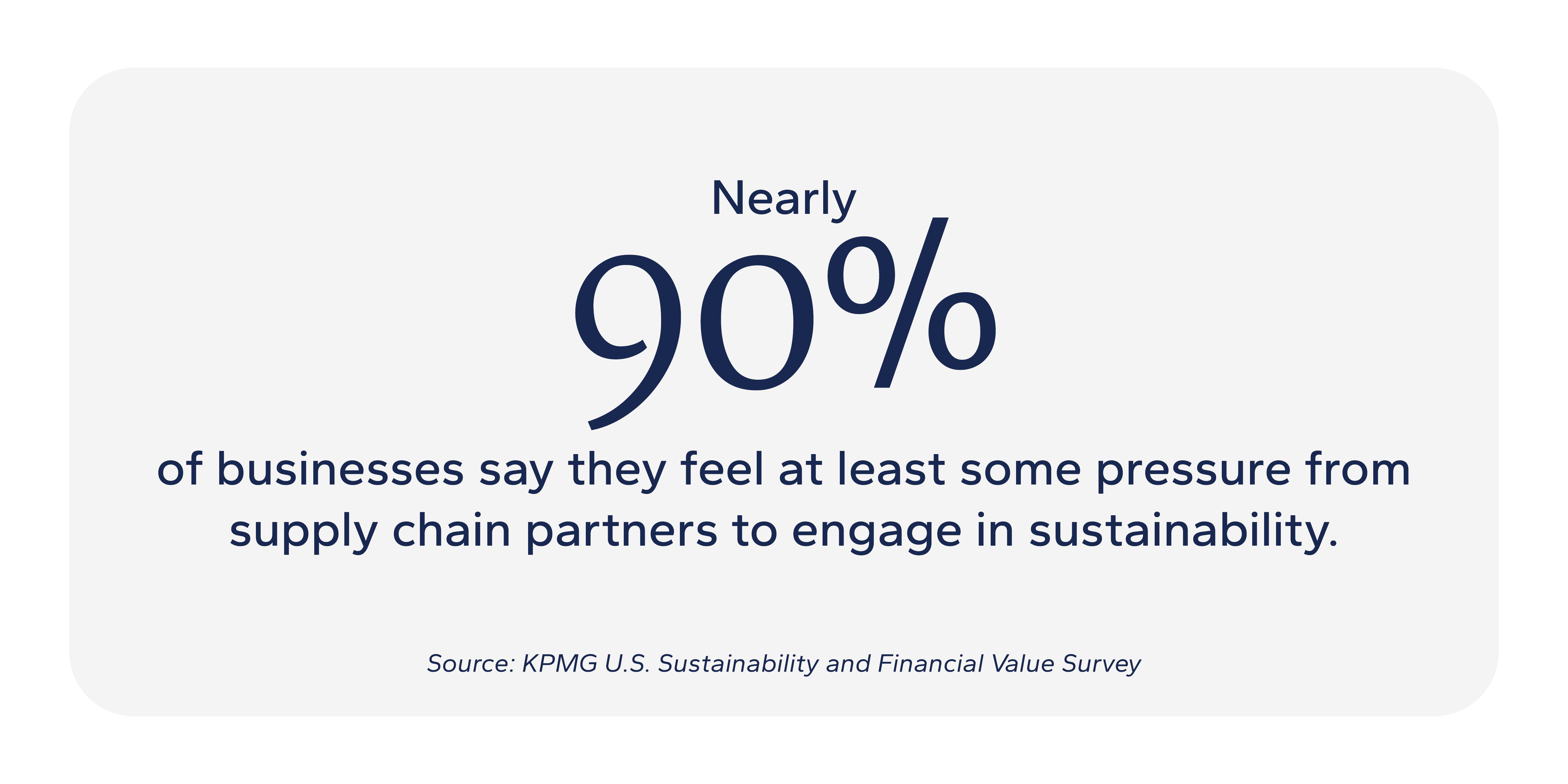Key Takeaways
- Nearly 90% of businesses feel at least some pressure from supply chain partners to engage in sustainability, according to a recent survey.
- Companies are zeroing in on supply chain operations as they realize that Scope 3 emissions are — on average — 11.4 times higher than operational emissions.
- A commitment to sustainability is increasingly important for reducing risk, attracting consumers and investors, and retaining talent.
The demand for transparency within supply chain sustainability is rapidly accelerating, as companies find themselves inundated with requests for data regarding their environmental, social, and governance (ESG) practices and performance. Around 25 countries are currently enforcing mandatory sustainability disclosure rules.
Rather than view this as a mere compliance exercise, strategic businesses recognize these requests as an opportunity to build trust with the companies requesting this information, bolster their brand image, and reap the benefits of embracing sustainability as a best practice.
Advancements in Supply Chain Sustainability Disclosure
Mounting pressures on supply chains have recently become the central driver for expanding sustainability disclosures.

Today’s businesses must navigate a maze of ESG and sustainability data requests, guided by multiple reporting standards and questionnaires.
- The number of companies requested to submit data to CDP escalated from 15,000 in 2020 to more than 75,000 in 2024.
- EcoVadis, a comprehensive sustainability assessment tool, has contacted over 100,000 companies.
- Industry-focused frameworks like the HIGG Index for the apparel sector and GRESB for real estate are also becoming prevalent.
These inquiries are diverse and tailored to each company's sustainability goals and risk profiles. While sharing social metrics like workforce diversity and compensation is a straightforward question, climate-related data — central to most companies’ sustainability objectives and risk mitigation strategies — poses a new and greater challenge.
Companies are advised to proactively collect and disclose pertinent greenhouse gas emissions data and climate-related risks to their customers.
The swell in demand for this data is attributed to emerging regulations mandating supply chain sustainability disclosures, escalating sustainability risks, and the recognition that supply chains are pivotal to a company’s overall sustainability footprint.
Scope 3 Emissions' Role in Supply Chain Sustainability
Companies are zeroing in on supply chain operations as they realize that Scope 3 emissions are — on average — 11.4 times higher than operational emissions. These emissions, largely beyond direct company control, necessitate collaborative efforts with suppliers for accurate measurement and effective reduction strategies.
Scope 3 emissions are a focal point in recent legislative frameworks, including California's SB 253 and the EU’s Corporate Sustainability Reporting Directive. They form a cornerstone of the International Sustainability Standards Board (ISSB) protocols, which inform numerous other ESG regulations globally.
Companies like Microsoft are mitigating Scope 3 emissions in their supply chains by including a stipulation in their supplier code of conduct that their suppliers report emissions annually through the CDP and begin setting their own carbon reduction targets.
How to Streamline Supply Chain Sustainability Reporting
Efficiently managing sustainability requests is crucial for maintaining strong relationships with customers and stakeholders. Companies that proactively address these requests can enhance their reputation, improve operational efficiency, and stay ahead of regulatory requirements. Here’s a straightforward approach to help you manage these requests effectively:
-
Prioritize ESG Inquiries:
Evaluate ESG data requests based on customer significance and the ease of fulfilling their request. Start with your most critical customers and gather the simplest, most commonly requested data. -
Compile ESG Data:
To meet the most common requests, which are likely to be for climate data, being proactive is key. You may need to invest outside resources to produce accurate replies and metrics. Utilizing sustainability management tools can streamline this process. -
Align with ESG Frameworks:
Choose reporting frameworks, such as CDP or EcoVadis, frequently requested by your customers, stakeholders, or investors. When possible, use multiple frameworks to cover a broader range of requests. -
Engage and Train Stakeholders:
Communicate the importance of compliance to all relevant parties and provide necessary training. -
Communicate Sustainability Transparently:
Foster an open, ongoing dialogue with your supply chain partners. Share your current sustainability performance data as well as your long-term goals and aspirations to build a transparent and trusting relationship. -
Regularly Review and Update:
Continuously improve your compliance strategies based on regulatory changes.
Advantages of Supply Chain Sustainability Efforts
Engaging in supply chain sustainability practices extends beyond just boosting brand reputation. Some additional advantages for suppliers can include:
Risk Reduction:
Staying abreast of sustainability metrics allows for a clear understanding of environmental risks, including climate change implications, enabling companies to build data-driven strategies to mitigate them.
Regulatory Readiness:
Your company may not be impacted by a sustainability disclosure regulation today. However, you should anticipate potential regulations to ensure future compliance. Collecting data today will set you up for success.
Attracting Consumers and Investors:
Proactively addressing sustainability can not only ensure compliance with sustainability regulations but also build trust with consumers and investors, and improved trust has been found to increase shareholder returns by up to 6%.
Presenting detailed sustainability data to investors enhances decision-making and opens avenues for favorable investment conditions.
Enhancing Operational Efficiency:
Committing to sustainability can translate to operational savings, according to ENERGY STAR’s research, which cites substantial energy cost reductions (10-30%) through minor energy efficiency enhancements.
Workforce Retention:
A commitment to sustainability is increasingly important for attracting and retaining talent, with studies indicating sustainability’s value in the eyes of current and prospective employees.
Initiating these practices now, in preparation for future Requests for Proposals, sets the stage for realizing these additional co-benefits.
Managing Your Supply Chain Sustainably
The frequency and breadth of sustainability data requests are on the rise. To stay ahead, companies must equip themselves with robust tools and methodologies for gathering essential data. This proactive strategy is not just about staying competitive — it’s about seizing new business opportunities and reducing potential risks.
Eide Bailly’s Sustainability team is here to help you navigate evolving regulations, so you can operate at peak performance and protect what you’ve worked so hard to build. To enhance your brand's image and leverage the full spectrum of benefits from effective sustainability management, consult with our team the next time an ESG survey gets sent your way.
Become empowered to navigate the future of climate-related reporting.
 Talk to our specialists
Talk to our specialists
